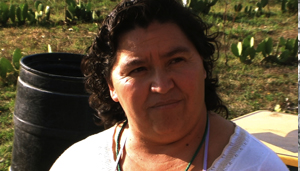Documenting the undocumented
By Ruth E. Kott, AM’07

Still from The Other Side of Immigration
In 2008, while Roy Germano, AM’03, was writing his doctoral dissertation at the University of Texas at Austin, he filmed a documentary about Mexican immigration to the United States—the economic and social reasons that people leave their home cities and what happens to those left behind. “The problem is the lack of opportunities in the Mexican countryside,” one man says in the film.
“I can’t make it here,” another man argues, “so I have to work in the US.” Winner of the 2011 American Library Association Notable Video Award, The Other Side of Immigration has been screened at more than 50 film festivals and university events. Germano, now a visiting assistant professor at UT, has become a popular interview subject on English- and Spanish-speaking news networks.
On-the-job education
My first introduction to the immigration issue came in 2003, when I worked as a waiter while finishing my master’s thesis at U of C. Many of my coworkers at the restaurant—the cooks, the busboys, the dishwashers—were undocumented immigrants from Mexico. Their stories about why they left home to work illegally in the United States inspired me to learn more about the root causes of Mexican immigration.
Cause for admiration
Anti-immigrant sentiment is at its highest level in a century, and the mainstream media play a significant role in perpetuating myths that immigrants are criminals or here to have anchor babies. So what are Americans to believe if this is the primary way they get information about immigrants? Since I’ve had the opportunity to learn so much about this issue, I feel a responsibility to do what I can to counter the myths. With a deeper understanding of the issue, I think many Americans would identify with, if not admire, those who make the very difficult and risky decision to migrate illegally.
Challenges of filmmaking
Money was definitely an issue. I funded the film with my own savings while living on a $14,000-a-year grad-student salary. That made it impossible to hire a crew or buy fancy equipment. There was a steep learning curve for certain tasks, like translation and subtitling (most of the film is in Spanish). And there was always pressure to keep up with dissertation writing. But looking back, I wouldn’t trade the experience. The process taught me countless lessons and proved to me that I am capable of stretching a dollar and producing a solid film under less-than-ideal circumstances.
Misconceived notions
The people I met in the Mexican countryside ... are the true immigration experts. Their eloquence and insights really come across in the film. This tends to surprise some people, I think because so many Americans grow up with the false notion that Mexicans are not articulate or insightful people. But these are just the types of stereotypes I hope the film can play some role in breaking down.
The other other side of immigration
While The Other Side of Immigration focuses entirely on Mexico, my next documentary will look more at border issues and immigration policy from the US perspective. I’m interested in making another film about immigration because, again, I think there are still a lot of stories and information that don’t make it into the mainstream media or our policy debate.
